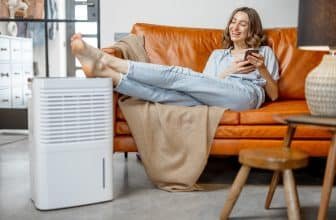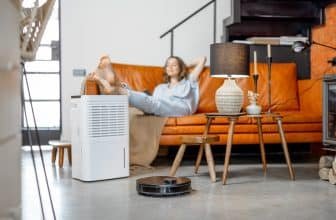Impact of Pets on Indoor Air Quality: How Air Purifiers Can Help Reduce Hair, Dander, and Odors
Pets are much-loved members of many households, but they can also have a significant impact on indoor air quality. Pet hair, dander, and odors can accumulate over time, leading to poor indoor air quality that can impact the health of both pets and their owners. Fortunately, air purifiers can help mitigate these issues by removing pet-related pollutants from the air.

Understanding Indoor Air Quality and Pet Influence
Indoor air quality is an important consideration for pet owners. According to the Environmental Protection Agency, indoor air can be two to five times more polluted than outdoor air. Pet-related pollutants, such as hair, dander, and odors, can contribute to this pollution. Pet hair and dander can trigger allergies and asthma, while pet odors can be unpleasant and difficult to remove.
Air Purifiers as a Solution
Air purifiers can help improve indoor air quality by removing pet-related pollutants from the air. High-efficiency particulate air (HEPA) filters can capture pet hair and dander, while activated carbon filters can help remove pet odors. Some air purifiers also feature ultraviolet (UV) light technology, which can kill bacteria and viruses that may be present in pet dander. By removing these pollutants from the air, air purifiers can help create a healthier, more comfortable living environment for both pets and their owners.
Clearing the Air: How Air Purifiers Combat Pet-Related Allergens and Odors
- Indoor air quality can be significantly impacted by pets, including pet hair, dander, and odors.
- Air purifiers can help improve indoor air quality by removing pet-related pollutants from the air.
- HEPA filters, activated carbon filters, and UV light technology are all effective solutions for removing pet-related pollutants from the air.
Understanding Indoor Air Quality and Pet Influence
Indoor air quality is a crucial aspect of maintaining a healthy and comfortable living environment. Poor indoor air quality can lead to various health problems, including respiratory issues, allergies, and asthma. Indoor air pollution is caused by various factors, including pet hair, dander, allergens, pollen, dust, and other contaminants.
Components of Indoor Air Pollution
Indoor air pollution is caused by various factors, including outdoor pollutants such as smog, pollen, and mold, as well as indoor pollutants such as pet hair, dander, and dust. The sources of indoor air pollution can vary depending on the location, the type of building, and the lifestyle of the occupants.
The Role of Pets in Air Quality Deterioration
Pets can be a significant source of indoor air pollution. Pet hair, dander, and other allergens can accumulate in the air and on surfaces, leading to respiratory issues and allergies. Pet odors can also be a significant source of indoor air pollution, and can be difficult to eliminate.
One of the ways to reduce the impact of pets on indoor air quality is through the use of air purifiers. Air purifiers can help to remove pet hair, dander, and other allergens from the air, making it easier to breathe. They can also help to eliminate pet odors, making the air fresher and more pleasant to breathe.
Overall, understanding the impact of pets on indoor air quality is crucial for maintaining a healthy and comfortable living environment. By taking steps to reduce the impact of pets on indoor air quality, such as using air purifiers, it is possible to create a healthier and more comfortable living environment for both humans and pets alike.
Health Implications of Poor Indoor Air Quality
Indoor air quality can have significant health implications, particularly for vulnerable populations such as children, the elderly, and those with respiratory conditions. Poor indoor air quality can lead to allergies, respiratory conditions, and other health problems.
Allergies and Respiratory Conditions
Poor indoor air quality can trigger allergies, asthma, and other respiratory conditions. Pet dander, hair, and odors can be particularly problematic for those with allergies or asthma. According to a study published in the Journal of Allergy and Clinical Immunology, exposure to pet allergens can increase the risk of developing asthma and other respiratory conditions. Symptoms of allergies and respiratory conditions can include sneezing, coughing, wheezing, and watery eyes.
Effects on Vulnerable Populations
Children, the elderly, and those with respiratory conditions are particularly vulnerable to the effects of poor indoor air quality. According to the Environmental Protection Agency, children are more susceptible to pollutants because they breathe more air relative to their body weight than adults do. The elderly may also be more susceptible to the effects of poor indoor air quality due to weakened immune systems. Those with respiratory conditions, such as asthma or chronic obstructive pulmonary disease (COPD), may experience worsening symptoms in the presence of pet dander, hair, and odors.
To reduce the risk of health problems associated with poor indoor air quality, it is important to take steps to improve air quality in the home. One effective way to reduce pet dander, hair, and odors is to use an air purifier. Air purifiers can help to remove pet allergens from the air, reducing the risk of allergies and respiratory conditions.
Air Purifiers as a Solution

Pet owners often face the challenge of maintaining good indoor air quality due to pet hair, dander, and odors. One solution to this problem is the use of air purifiers. Air purifiers are devices that remove airborne pollutants from the air in a room. They work by drawing in air, filtering out pollutants, and then releasing clean air back into the room.
How Air Purifiers Work
Air purifiers use various types of filters to remove pollutants from the air. The most common type of filter used in air purifiers is the HEPA filter. HEPA stands for High-Efficiency Particulate Air and is a type of filter that can capture particles as small as 0.3 microns. This includes pet hair, dander, and other allergens.
In addition to HEPA filters, air purifiers may also use pre-filters, activated carbon filters, and carbon filters. Pre-filters capture larger particles such as pet hair and dust. Activated carbon filters and carbon filters are effective at removing odors from the air.
Types of Filters and Their Functions
Air purifiers can have multiple filters, each with a specific function. The pre-filter is the first line of defense against larger particles such as pet hair and dust. It captures these particles before they can reach the HEPA filter, which can become clogged with larger particles and lose its effectiveness over time.
The true HEPA filter is the most important filter in an air purifier. It captures particles as small as 0.3 microns, which includes pet dander and other allergens. The activated carbon filter and carbon filter are effective at removing odors from the air, including pet odors.
Choosing the Right Air Purifier for Pet Owners
When choosing an air purifier for pet owners, it is important to consider the size of the room, the type of filter used, and the noise level of the device. A larger room will require a larger air purifier with a higher CADR (Clean Air Delivery Rate). The CADR is a measure of how much clean air an air purifier can deliver per minute.
Pet owners should look for air purifiers with a true HEPA filter, as this is the most effective filter for capturing pet dander and other allergens. Activated carbon filters and carbon filters are also important for removing pet odors.
In conclusion, air purifiers can be an effective solution for pet owners looking to improve indoor air quality. By using filters such as HEPA, pre-filter, activated carbon, and carbon filter, air purifiers can remove pet hair, dander, and odors from the air. When choosing an air purifier, pet owners should consider the size of the room, the type of filter used, and the noise level of the device.
Additional Strategies for Improving Indoor Air Quality
In addition to using air purifiers to reduce pet hair, dander, and odors from pets, there are several other strategies that can help improve indoor air quality. These strategies include regular cleaning and grooming, proper ventilation and airflow, and integrating plants and natural solutions.
Regular Cleaning and Grooming
Regular cleaning and grooming of pets can help reduce the amount of hair and dander that is released into the air. This can be done by brushing pets regularly, bathing them as needed, and wiping down surfaces with a damp cloth or mop. It is also important to vacuum carpets and furniture regularly, using a vacuum cleaner with a HEPA filter to trap airborne particles.
Proper Ventilation and Airflow
Proper ventilation and airflow can also help improve indoor air quality. This can be achieved by opening windows and doors to allow fresh air to circulate, using exhaust fans in bathrooms and kitchens to remove moisture and odors, and using air conditioning systems with clean filters to circulate and filter the air. It is also important to avoid smoking indoors and to limit the use of candles and other sources of indoor air pollution.
Integrating Plants and Natural Solutions
Integrating plants and natural solutions can also help improve indoor air quality. Plants such as spider plants, peace lilies, and snake plants can help remove pollutants from the air, while natural solutions such as baking soda, vinegar, and essential oils can be used to clean and deodorize surfaces. It is important to research the specific plants and solutions that are safe for pets before using them in the home.
Overall, by combining the use of air purifiers with these additional strategies for improving indoor air quality, pet owners can create a healthier and more comfortable living environment for both themselves and their pets.
Maintenance and Care of Air Purifiers

Air purifiers require regular maintenance to ensure optimal performance. Neglecting maintenance can lead to poor air quality and even damage to the air purifier. Here are some tips for maintaining and caring for air purifiers:
Cleaning and Replacing Filters
The filters in air purifiers are what capture pet hair, dander, and other pollutants. Over time, these filters become clogged with debris and need to be cleaned or replaced. Many air purifiers have a filter replacement indicator that alerts the user when it’s time to change the filter. It’s important to follow the manufacturer’s instructions for cleaning and replacing filters.
Some filters are washable, while others are disposable. Washable filters can be cleaned with water and mild soap, but should be completely dry before being reinstalled. Disposable filters should be replaced according to the manufacturer’s recommendations.
Assessing Air Purifier Performance
Air purifiers are rated based on their CADR (Clean Air Delivery Rate) which indicates how quickly the air purifier can clean the air in a room. It’s important to choose an air purifier with a CADR rating that’s appropriate for the size of the room where it will be used.
Different air purifiers use different technologies to clean the air. Some use HEPA filters to capture pollutants, while others use activated carbon to absorb odors. It’s important to choose an air purifier with the appropriate technology for the pollutants you want to remove.
In summary, maintaining and caring for air purifiers is essential to ensure optimal performance and clean indoor air. Regularly cleaning or replacing filters, following manufacturer’s instructions, and choosing an air purifier with appropriate CADR rating and technology will help keep your air purifier running smoothly and your indoor air clean.
Advanced Air Purifying Technologies for Pet Owners

Pet owners often face the challenge of managing pet hair, dander, and odors in their homes. Advanced air purifying technologies can help reduce these allergens and pollutants, providing relief to those experiencing symptoms of allergies.
Innovations in Filtration and Air Cleaning
HEPA filters are the most effective filters for removing pet hair and dander from the air. These filters can capture particles as small as 0.3 microns, including pet allergens. Activated carbon filters can help remove pet odors and volatile organic compounds (VOCs) from the air.
Some air purifiers use a combination of HEPA and activated carbon filters to provide comprehensive air cleaning. For example, the Levoit Pet CoreP350 Air Purifier uses a custom filter that deodorizes the air while effectively pulling out dander, hair, and other allergens.
Smart Features and Automatic Adjustments
Smart air purifiers are becoming increasingly popular among pet owners. These devices can monitor the air quality in a room and adjust their settings accordingly. For example, the Coway Airmega 400S features a built-in sensor that detects the level of pollutants in the air and adjusts the fan speed accordingly.
Some air purifiers also come with auto mode, which automatically adjusts the fan speed based on the air quality. This feature can be particularly useful for pet owners, as it ensures that the air purifier is always working at the optimal level.
In conclusion, advanced air purifying technologies can help pet owners manage pet hair, dander, and odors in their homes. HEPA and activated carbon filters are the most effective filters for removing pet allergens and odors from the air. Smart features and automatic adjustments can help ensure that the air purifier is always working at the optimal level.
The Science and Engineering Behind Air Purifiers

Air purifiers are designed to remove impurities and contaminants from the air, including pet hair, dander, and odors. These devices use a variety of technologies, including HEPA filters, activated carbon filters, and UV-C lights, to trap and eliminate these pollutants.
Understanding MERV and CADR Ratings
Two important metrics for evaluating the effectiveness of air purifiers are MERV and CADR ratings. MERV stands for Minimum Efficiency Reporting Value and is used to rate the effectiveness of air filters. The higher the MERV rating, the more effective the filter is at removing particles from the air. For pet owners, a MERV rating of 8 or higher is recommended to effectively capture pet hair and dander.
CADR, or Clean Air Delivery Rate, measures the volume of clean air produced by an air purifier in a given amount of time. This rating is particularly important for pet owners, as it indicates how quickly the purifier can remove pet hair, dander, and odors from the air. A CADR rating of at least 100 is recommended for pet owners.
The Efficacy of Different Purifier Designs
Different air purifier designs are available, each with its own strengths and weaknesses. For example, HEPA filters are highly effective at capturing pet hair and dander, but may not be as effective at removing odors. Activated carbon filters, on the other hand, are highly effective at removing odors but may not be as effective at capturing pet hair and dander.
UV-C lights are another technology used in air purifiers, which can kill bacteria and viruses in the air. However, UV-C lights are less effective at capturing pet hair and dander, and may not be suitable for pet owners with allergies.
Overall, the most effective air purifier for pet owners will depend on their specific needs and preferences. It is important to consider factors such as MERV and CADR ratings, as well as the type of filter and technology used in the purifier, when selecting a device.
Lifestyle Benefits of Using Air Purifiers
Air purifiers offer numerous benefits to pet owners, including improving the quality of indoor air and reducing pet hair, dander, and odors. But did you know that using air purifiers can also have lifestyle benefits? Here are some of the ways air purifiers can improve your daily life and overall well-being.
Improvement in Sleep and Daily Comfort
Poor indoor air quality can negatively impact sleep and overall comfort. Air purifiers can help improve air quality by removing pollutants and allergens, such as pet dander, which can lead to better sleep and daily comfort. A study published in the Journal of Allergy and Clinical Immunology found that using air purifiers in the bedroom led to significant improvements in asthma symptoms and sleep quality. By reducing allergens and pollutants in the air, air purifiers can help create a more comfortable and restful sleeping environment.
Impact on Overall Well-being and Productivity
Breathing clean air can have a positive impact on overall well-being and productivity. Air purifiers can help remove harmful pollutants and allergens from indoor air, leading to a healthier environment. This can help reduce the risk of respiratory problems and other health issues associated with poor indoor air quality. By improving air quality, air purifiers can also help boost productivity by reducing the number of sick days taken by employees. A study by the National Institute for Occupational Safety and Health found that improved indoor air quality led to a significant reduction in employee sick days.
In conclusion, air purifiers offer numerous lifestyle benefits, including improving sleep and daily comfort, as well as overall well-being and productivity. By removing pollutants and allergens from indoor air, air purifiers can help create a healthier and more comfortable environment for pet owners.
Frequently Asked Questions

What are the most effective ways to reduce pet dander in the home?
The most effective ways to reduce pet dander in the home include regular cleaning, grooming, and using air purifiers. Regular cleaning involves vacuuming carpets, rugs, and furniture with a HEPA filter vacuum cleaner. Grooming pets regularly can also reduce the amount of dander they shed. Brushing pets outside can help prevent dander from accumulating inside the home.
Can air purifiers eliminate the risk of pet-related allergies?
While air purifiers cannot completely eliminate the risk of pet-related allergies, they can help reduce the amount of pet dander, hair, and odors in the air. Air purifiers with HEPA filters can capture small particles, including pet dander, from the air. However, it is important to note that air purifiers cannot remove pet dander and hair that has settled on surfaces.
How often should air purifiers be used to combat pet odors?
The frequency of air purifier use to combat pet odors depends on the level of odors in the home. It is recommended to use an air purifier continuously in rooms where pets spend most of their time. For areas with occasional pet odors, air purifiers can be used as needed.
What features should I look for in an air purifier to handle pet hair and dander?
When looking for an air purifier to handle pet hair and dander, it is important to choose one with a HEPA filter. HEPA filters can capture small particles such as pet dander, hair, and dust. It is also important to choose an air purifier with a pre-filter to capture larger particles such as pet hair and fur. Additionally, air purifiers with activated carbon filters can help reduce pet odors in the home.
How do pets contribute to poor indoor air quality and what can be done about it?
Pets contribute to poor indoor air quality by shedding dander, hair, and fur, which can accumulate in the air and on surfaces. Additionally, pet odors can also contribute to poor indoor air quality. Regular cleaning, grooming, and using air purifiers can help reduce the amount of pet dander, hair, and odors in the air and on surfaces.
Are there specific types of air purifiers that are more suitable for homes with multiple pets?
Air purifiers with multiple filters such as HEPA, pre-filter, and activated carbon filters are more suitable for homes with multiple pets. Additionally, air purifiers with higher CADR (clean air delivery rate) ratings can clean the air in larger rooms more efficiently. It is also important to choose an air purifier with a larger coverage area to ensure that all areas where pets spend time are covered.
best air purifiers
My name is Philipp Walz, editor at best-air-purifiers.com, and I’m truly passionate about creating healthier living spaces through smart, effective air purification. For me, air purifiers aren’t just appliances – they’re a quiet revolution in how we breathe, live, and feel at home. Clean air means better sleep, clearer thinking, and fewer allergies. It’s about giving our bodies what they need most: pure, fresh air. I’ve experienced firsthand how the right air purifier can transform a space and improve well-being – and I’m here to help others discover that difference. Because when you breathe better, you live better.






